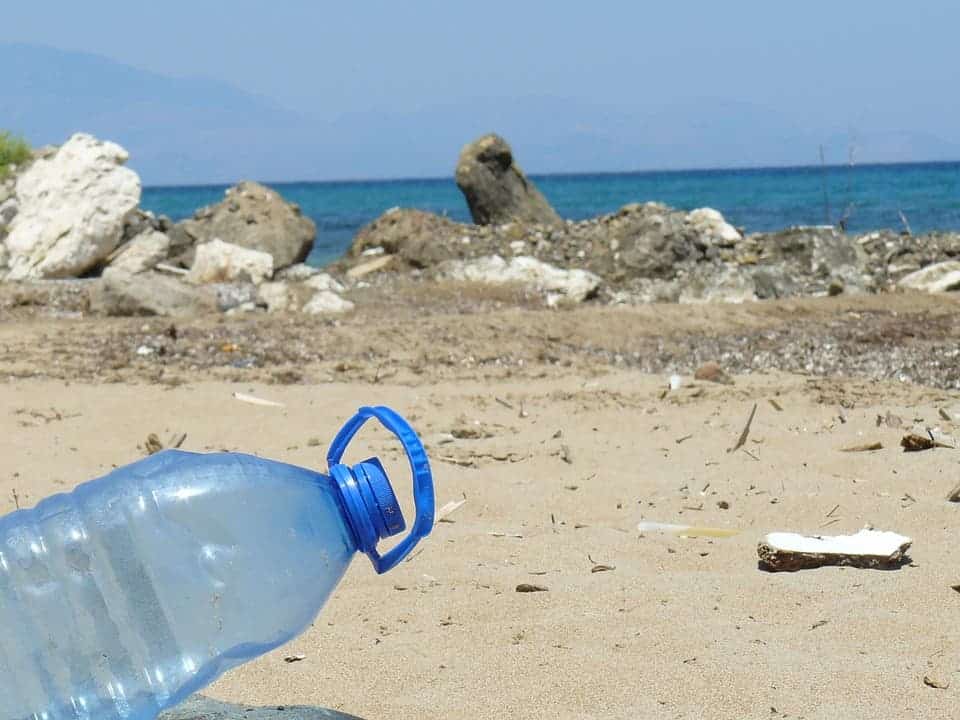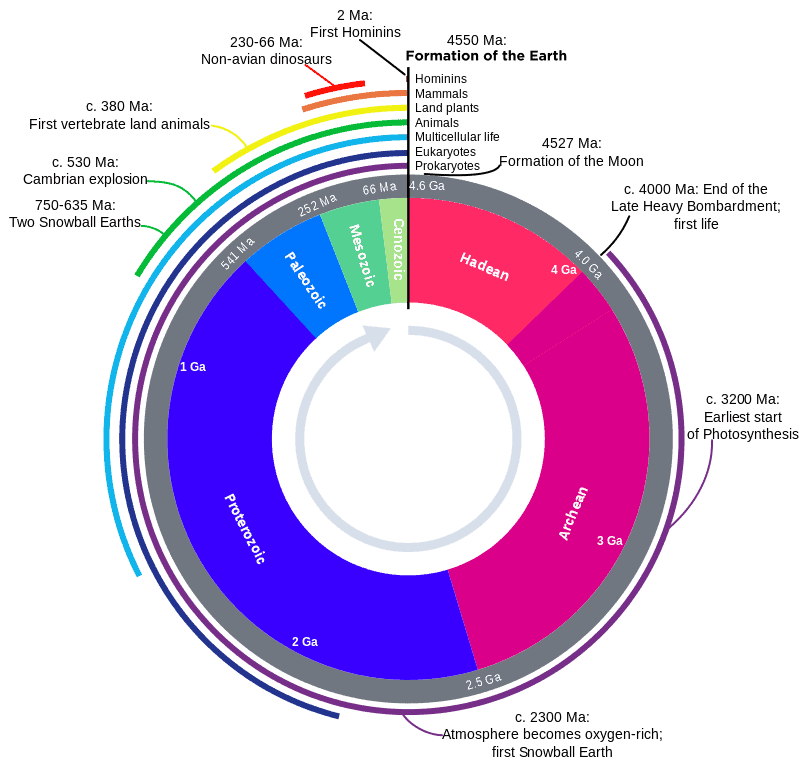Our impact as a species on the Earth has become so profound that we need to declare the start of a new geological epoch defined by us, the Anthropocene, experts believe. The proposal was presented to the International Geological Congress in Cape Town on Monday.

The new geological epoch should begin roughly in the 1950s, the experts said, and will most likely be defined by the radioactive elements blown across the planet by our nuclear weapons tests. But there’s no shortage of signals being considered — including plastic pollution, soot from power stations, concrete, even the bones left worldwide by the domestic chicken could prove to be valid delimiters.
New times
Among the first things they teach you in geology is the time scale — our attempt to organize and make sense of the immense periods of time involved in geological processes. One of the main divisions of geological time are called epochs, and the one we’re living in now — the Holocene — has been going on for about 12,000 years. It’s marked by a period of climate stability after the last ice age, and all human civilization up to now has developed in this epoch.

Image via Wikimedia.
But conditions are changing. The 20th century has seen a huge increase in free carbon dioxide levels in the planet’s atmosphere, coupled with sea level rise, global extinctions and significant transformation of the land in the form of deforestation, mining, and other development. The planet has changed so much so fast that conditions now don’t match conditions a few thousand, even hundreds of years ago — a window of time that’s barely significant in geological terms. This, the experts believe, means that the Holocene must give way to the Anthropocene.
“The significance of the Anthropocene is that it sets a different trajectory for the Earth system, of which we of course are part,” said Prof Jan Zalasiewicz, a geologist at the University of Leicester and chair of the Working Group on the Anthropocene (WGA), which started work in 2009.
“If our recommendation is accepted, the Anthropocene will have started just a little before I was born,” he said. “We have lived most of our lives in something called the Anthropocene and are just realising the scale and permanence of the change.”
We’re the main players now
Now, before you start celebrating that we’re no longer just a geological force, but one that defines a whole epoch in our planet’s development, take a second and consider what sort of responsibility this puts on us. We’re no longer a group of primates scared hairless at the world around it — we’re safe from predators, safe from the cold or heat, reasonably safe from disease, and there’s plenty of food to go around (we still have to work on the “around” part, though.) We’re no longer at the mercy of the world around us — we shape the world around us.
“Being able to pinpoint an interval of time is saying something about how we have had an incredible impact on the environment of our planet. The concept of the Anthropocene manages to pull all these ideas of environmental change together,” added Prof Colin Waters, principal geologist at the British Geological Survey and WGA secretary.
“The Anthropocene marks a new period in which our collective activities dominate the planetary machinery,” said Prof Chris Rapley, a climate scientist at University College London and former director of the Science Museum in London, who is not part of the WGA.
“Since the planet is our life support system – we are essentially the crew of a largish spaceship – interference with its functioning at this level and on this scale is highly significant. If you or I were crew on a smaller spacecraft, it would be unthinkable to interfere with the systems that provide us with air, water, fodder and climate control. But the shift into the Anthropocene tells us that we are playing with fire, a potentially reckless mode of behaviour which we are likely to come to regret unless we get a grip on the situation.”
Martin Rees, the astronomer royal and former president of the Royal Society, said that the dawn of the Anthropocene was a significant moment.
“The darkest prognosis for the next millennium is that bio, cyber or environmental catastrophes could foreclose humanity’s immense potential, leaving a depleted biosphere.”
“Human societies could navigate these threats, achieve a sustainable future, and inaugurate eras of post-human evolution even more marvellous than what’s led to us. The dawn of the Anthropocene epoch would then mark a one-off transformation from a natural world to one where humans jumpstart the transition to electronic (and potentially immortal) entities, that transcend our limitations and eventually spread their influence far beyond the Earth.”
[panel style=”panel-default” title=”Evidence of the Anthropocene include:” footer=””]
- Rising plant and animal extinction rates. If conditions don’t improve, our planet will lose 75% of species in the next few centuries.
- CO2 levels in the atmosphere rising faster than ever in the last 66 million years. The level was 280 ppm before the industrial revolution and it’s gone up to 400ppm and rising today.
- Huge amounts of plastic in oceans and waterways. Microplastic particles are now virtually ubiquitous, and plastics will likely form geological structures identifiable in the future.
- Nitrogen and phosphorus levels in agricultural soils have doubled over the past century (chemical fertilizers.) This likely constitutes the largest impact on the nitrogen cycle in 2.5bn years.
- A layer of airborne particulates in sediment and glacial ice such as black carbon from fossil fuel burning.
[/panel]
While humanity’s effect on the planet is highly evident, the short window of time in which they’ve taken place — epochs usually span tens of millions of years — was used to criticise the idea of an Anthropocene.
“One criticism of the Anthropocene as geology is that it is very short,” said Zalasiewicz. “Our response is that many of the changes are irreversible.”
Each geological epoch needs a marker that can be used to differentiate between it and the previous one, a signal that can be picked up in the future geological record. The end of the Cretaceous some 66m years ago is defined by a spike in iridium in sediments across the world, dispersed by the same meteorite that killed off the dinosaurs. The best candidate for the Anthropocene are the radioactive elements that settled all over the world following nuclear weapons tests.
“The radionuclides are probably the sharpest – they really come on with a bang,” said Zalasiewicz. “But we are spoiled for choice. There are so many signals.”
Other spikes being considered as evidence of the onset of the Anthropocene include the tough, unburned carbon spheres emitted by power stations, plastic pollution, aluminum and concrete particles, or high levels of nitrogen and phosphate in soils derived from artificial fertilizers. As for marker fossils, the domestic chicken is an unlikely but very serious suggestion to define the Anthropocene for future geologists.

Image credits skeeze / pixabay.
“Since the mid-20th century, it has become the world’s most common bird. It has been fossilised in thousands of landfill sites and on street corners around the world,” said Zalasiewicz. “It is is also a much bigger bird with a different skeleton than its prewar ancestor.”
Out of the 35 members of the WGA, 30 voted in favour of formally designating the Anthropocene, 3 against and 2 were absent. The group will be spending the next two to three years determining which signal will become the official indicator of the epoch, and the type location for it — geological divisions are not defined by dates but by a specific boundary between layers of rock or, in the case of the Holocene, a boundary between two ice layers in a core taken from Greenland and now stored in Denmark.
They’re focusing on sites with annual layer formation, such as mud sediments off the coast of Santa Barbara in California and the Ernesto cave in northern Italy, where stalactites and stalagmites accrete annual rings. Lake sediments, ice cores from Antarctica, corals, tree rings and even layers of rubbish in landfill sites are also being considered.
Once the data has been assembled, it will be formally submitted to the stratigraphic authorities and the Anthropocene could be officially adopted within a few years.
“If we were very lucky and someone came forward with, say, a core from a classic example of laminated sediments in a deep marine environment, I think three years is possibly viable,” said Zalasiewicz.
But geologists are trained to think in terms of millions of years and despite the WGA’s expert recommendation, the Anthropocene might take just as long to catch on.
“Our stratigraphic colleagues are very protective of the geological time scale. They see it very rightly as the backbone of geology and they do not amend it lightly,” said Zalasiewicz. “But I think we can prepare a pretty good case.”
Rapley also believes that they have a solid case for the Anthropocene.
“It is highly appropriate that geologists should pay formal attention to a change in the signal within sedimentary rock layers that will be clearly apparent to future generations of geologists for as long as they exist. The ‘great acceleration’ constitutes a strong, detectable and incontrovertible signal.”






